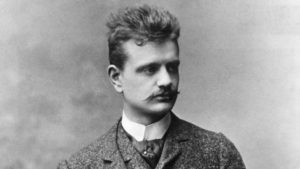Regarding Finnish composer Jean Sibelius’s fascination with nature, his biographer, Tawaststjerna famously wrote that “even by Nordic standards, Sibelius responded with exceptional intensity to the moods of nature and the changes in the seasons: he scanned the skies with his binoculars for the geese flying over the lake ice, listened to the screech of the cranes, and heard the cries of the curlew echo over the marshy grounds just below Ainola. He savoured the spring blossoms every bit as much as he did autumnal scents and colors.” Such a sentiment is echoed by no piece of Sibelius’ more than his Suite Mignonne, originally scored for two flutes and string orchestra.
 The first movement of the suite, entitled “Petite Scene” opens with a theme of a delightful hesitancy, and short dance-like passages weave their way between effectively placed moments of stillness. The effect conjured is not entirely dissimilar to watching a small bird flit and hop its way through overgrown patches of marshland. The brilliance of this movement lies in its ability to convey the refreshing breezes of the open country air while seamlessly transitioning into the following movement, “Polka”.
The first movement of the suite, entitled “Petite Scene” opens with a theme of a delightful hesitancy, and short dance-like passages weave their way between effectively placed moments of stillness. The effect conjured is not entirely dissimilar to watching a small bird flit and hop its way through overgrown patches of marshland. The brilliance of this movement lies in its ability to convey the refreshing breezes of the open country air while seamlessly transitioning into the following movement, “Polka”.
The second movement of the Mignonne Suite truly captures the essence of its namesake, for “mignonne” is French for “daintily small” or “delicate” depending on the context in which it is used. As the birds from movement one grow chattier and bolder in nature, the melody becomes increasingly fixated on their pizzicato chirping. Sibelius’ writing for the cello in this section is quite challenging, as the part they play is very exposed and requires each cellist to create a contrasting texture for the lines of those who are bringing the “birds” to life.
Sibelius gave his son-in-law (the cellist Jussi Jalas) some directions for maximizing his expressive efficiency when performing this suite. The composer was insistent that “there should be a brief pause before the last eight bars of the first movement” and that “the Polka should be played slowly and without excessive stretto at the end.” He advised young Jussi that the suite’s final movement “should be rhythmically straight, without ritardando.”
And does this “Epilogue” ever fly without ritardando! The birds take to the sky, one by one, and the perfectly timed pauses in the string section work to effectively build excitement. A dream-like passage focuses our attention on the hazy clouds above the marshland before we are thrown once again (if only briefly) into the busy and joyful world of our avian friends. This “Epilogue” functions as a partial recapitulation of the “Petite Scene” to perfectly frame the lighthearted Polka. Sibelius’ romantic appraisal of the great outdoors is alive in his music, and it speaks to us in every season we can gaze out from our windows (be they frosted or smattered with rain) to see birds on the wing.